|
Thank you for subscribing to this newsletter. This is a place for us to update you on what we are doing at South Hams District Council and what things are going on around the District. It will tell you what's going on nationally and things you, our residents and businesses, can be doing to reduce your carbon footprint and manage your land to improve the environment and its biodiversity.
If you have anything you would like to include in this newsletter then contact our Climate Change Specialist by email here and follow us on Twitter and Facebook.

Thousands of new trees will be planted across Plymouth and South Devon, after the area was chosen to become England’s 11th community forest.
The Plymouth and South Devon Community Forest will stretch from the heart of the city to the edge of the moor, encompassing 1,900 hectares of land to form a mosaic of different forest habitats.
Unlike traditional forests, community forests aren’t geographically restricted to one place. Instead, they are a spread out across a mix of community woodland, private woodland, on street, urban woodland, wooded habitat corridors and hedgerows.
It is envisaged that by connecting the rich ecosystems and habitats of Dartmoor and the wider South Devon area and bringing them into the city we can improve our connection to, and enjoyment of nature for future generations.
Delivering the community forest for future generations is a core part of the proposal in recognition of young people’s voices in recent climate emergency discussions and the recovery from the impact of Covid.
The opportunities that the community forest creates will ensure skills development and job creation will be relevant to today and tomorrow’s young people and generate a sustainable natural asset for future generations.
Furthermore, the planning of the community forest fulfils an action on the Climate Emergency Action Plan, allowing the Council to play a leadership role by working with partners and the local community across the city to raise awareness and understanding around climate change.
The proposals have been drawn up by a broad initial partnership between Plymouth City Council, National Trust, Woodland Trust, South Hams District Council and West Devon Borough Council, the Forestry Commission, Forestry England, Devon Wildlife Trust, Plymouth Tree Partnership and Dartmoor National Park and is funded through the Department of Environment, Farming and Rural Affairs’ Nature for Climate fund.
Councillor Patrick Nicholson, Deputy Leader of Plymouth City Council, said: “We are absolutely delighted to be involved in such a brilliant and important project.
“The new community forest will not only compliment our commitment to tree planting and the continuing greening of our City, which is important post COVID, but ties in perfectly with our plans for education and skills training.
“I look forward to the delivery of this project and the community’s involvement.”
Councillor Judy Pearce, Leader of South Hams District Council said: “The ambitious aspiration for the community forest can deliver real and lasting benefits for nature and our local communities.”
With the forest funding now approved, the partnership will begin work with the next phase of the development.
This will involve appointing a project delivery team, consulting on and developing the forest plan and identifying sites for the first year’s planting.
If you are interested in finding out more please email PSDCF@plymouth.gov.uk
|
Webinar Highlights

Climate Justice: A just transition - 7th July
Organised by the Centre for Alternative Technology (CAT), on 7 July, CAT lecturer Scott Leatham and CAT student Tanya Hawkes will explore the theory and practice of the just transition movement in the UK. For more information and to register, click here.
|

Creative Practices that Tread Lightly on the Earth: Workshop to Develop a Sustainable, Low Carbon Studio
Wednesday 7 July, 16:00 -18:00
- Are you a maker, designer, crafts person, artist, creative?
- Do you want to learn how to create a sustainable studio?
As part of the Green Maker Initiative launched by Low Carbon Devon and Devon Guild of Craftsmen, join our free online workshop to learn from national experts; Caro Overy, Creative Carbon Scotland, Lauren England, University of Dundee, Julian Leedham, designer-maker, fabricator and hosted by Polly Macpherson, Associate Professor of Design at the University of Plymouth.
Click here to find out more and register.
|

Inspire Ambition: Purposeful Business
Thursday 15 July, 16:30 - 18:00
What does purposeful business look like? How can we put purpose before profit for the good of the planet and people? Join guest speakers and panelists to explore how purposeful business can catalyse action on climate change and enable a shift towards a zero carbon future
Click here to find and more and register.
|
Get Involved
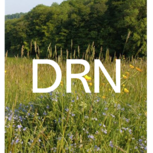
Join the Devon Rewilding Network
Ambios Ltd are working in collaboration with The Woodland Trust and Rewilding Britain to help facilitate a network of people based in Devon, who are interested in rewilding.
The first phase of this forum will be to act as a notice board, where the most recent and relevant events and content on rewilding in Devon will be posted
Click here to find out more and to join .
|
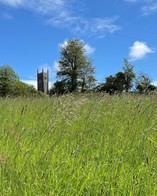
Greener Ugboorugh Parish improving local biodiversity! - Written by Susan Williams
Greener Ugborough Parish capitalised upon spring by launching a Wildlife and Biodiversity working group earlier this year. Now – with a focus on local skills, taking positive action and shared learning - various restoration activities are underway. These aim to increase local biodiversity, local pollinator activities and draw down carbon from the atmosphere.
In April we took on the management of half an acre at the Parish Burial Ground. The objective being to produce a species-rich grassland habitat, encouraging community engagement in local wildlife and biodiversity conservation and creating a little nature reserve for the community.
|
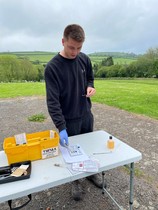
Firstly, we found what was already growing, with a soil analysis and grass survey. Rough grassland was indicated, dominated by tussocky grasses like Cock’s-foot and False Oat-grass. Raking up dead grasses allowed light and rain to get to the soil and we waited to see what appeared.
A detailed survey of flora in June was very promising. We identified four more species of grass, including the aptly named Meadow Foxtail. There were over 25 plant species, with Hogweed and Greater Birds Foot Trefoil, whose flowers will feed all sorts of insects until well into the autumn. We also found Yellow Rattle, a hemi-parasite, producing its own food through photosynthesis but also scrounging nutrients through the roots of the grass that it parasitises. It thins the grass enough to allow other flowers to germinate and reach the sunlight. One amazing find was a Southern Marsh Orchid. Who knows what might pop up next!
|
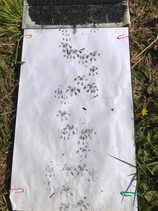
Our surveying also included the local fauna. Footprint traps revealed evidence of hedgehog and small rodents. Pitfall traps caught millipedes, true bugs, ants, harvestman, spiders, and beetles, which were then released. Sweep netting added Grasshoppers and Crickets to our list. Five butterflies have been seen so far including the Ringlet and Large Skipper. A Silver Y moth has been feeding during the day on Red Campion flowers. Wildlife camera footage has recorded a resident Tawny Owl, and a Buzzard is regularly seen circling overhead. All that we have recorded can be found on the i-Naturalist App in the Ugborough Wildlife Project.
|
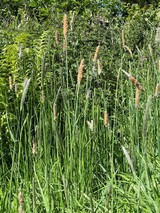
Having gathered all the information, we have come up with a plan for how best to manage the site. Two thirds will be managed by topping every two years, building up a thick, matted, tussocky mix of grasses with a deep thatch. This provides an ideal habitat for Field Voles by providing cover for their tunnels and nest, which in turn supports owls and other birds of prey. The rest will be managed as wildflower meadow by cutting in late Summer and removing the clippings. Then in Autumn we will be sowing wildflower seeds that we will collect from local meadows. Paths have been cut through the grass to allow visitors to see the different types of grassland as they develop.
We have quite a few things planned - additional surveying later in the Summer, continuing invasive species removal, interpretation boards and school involvement. Also, we will be using a moth light trap and are very excited to see what we will catch.
Would you like to get involved with this project? Please get in touch for more information greenerugp@gmail.com
|
Sustainable South Brent - Waste Not Want Not
14 August 10am to 4pm at the Old School Community Centre
Sustainable South Brent are holding a day of activities centered on the theme of 'Waste Not Want Not. The day includes a Jumble Sale, restyling an old t shirt, advice on how to alter and change tired clothes, re-using material and making tote bags, street stalls selling sustainable products and an artist showing awareness of nature to children through paint and collage are among the many activities on the day. For more information Contact Sue Astal-Stain cosycornercrafts@gmail.com

On 24 June, the Climate Change Committee published its independent assessment of UK progress to reduce emissions and adapt to Climate Change.
Some key messages were;
- A Net Zero Test would ensure that all Government policy, including planning decisions, is compatible with UK climate targets.
- An ambitious Heat and Buildings Strategy, that works for consumers, is urgently needed.
- Delayed plans on surface transport, aviation, hydrogen, biomass and food must be delivered.
- Plans for the power sector, industrial decarbonisation, the North Sea, peat and energy from waste must be strengthened.
- The big cross-cutting challenges of public engagement, fair funding and local delivery must be tackled.
- Only five of 34 sectors assessed have shown notable progress in the past two years, and no sector is yet scoring highly in lowering its level of risk
To read the report in full, click here
|
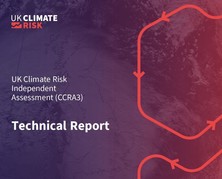
The UK Government is required, under the 2008 Climate Change Act, to publish a Climate Change Risk Assessment (CCRA) every five years. In June 2021, an Independent Assessment of UK Climate Risk was published.
Alongside mitigation, such as reducing greenhouse gas emissions, adaption is needed, as whilst the climate changes, further changes are inevitable as a result of historic greenhouse gas emissions.
Since the previous Climate Change Risk Assessment 23 risks from climate change in England have increased in urgency score.
The assessment found that there is increasing evidence that risks from extreme heat are greater in England than elsewhere, this will affect health, infrastructure and the natural environment.
The potential for water scarcity and subsidence also appears to be a greater. Flooding (coastal and inland), storms, lightning and high winds also at increasing risk.
To read the reports in full, click here.
|
|